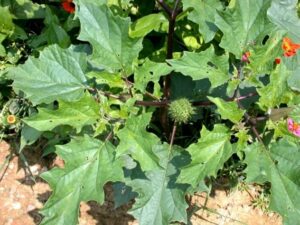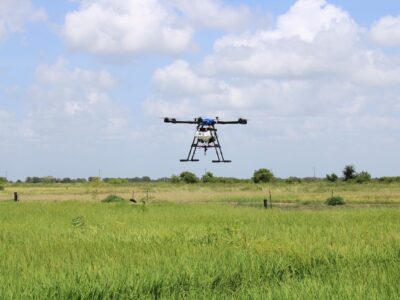Mustard Species in Wheat
For details on the biology and management of the following mustard species in wheat, see this publication from Oklahoma State University.
- Smallseed falseflax (Camelina microcarpa)
- Shepherd’s-purse (Capsella bursa-pastoris)
- Tansymustard (Descurainia pinnata)
- Flixweed (Descurainia sophia)
- Bushy wallflower (Ersimum repandum)
- Greenflower pepperweed (Lepidium densiflorum)
- Virginia pepperweed (Lepidium virginicum)
- Tumble mustard (Sisymbrium altissimum)
- Field pennycress (Thlaspi arvense)
Wild Mustard/Wild Radish
Sinapis arvensis, wild mustard
Raphanus raphanistrum, wild radish
Note: This information is based on experience in the Mid-Atlantic states; recommendations in other regions may vary.
Wild mustard and wild radish are in the Brassicaceae (mustard) family, and both are found throughout the Mid-Atlantic region. Both are winter annuals with fall germination; however, wild mustard and wild radish are also capable of spring emergence. Typically, both species emerge during the fall and overwinter in the rosette stage. The following spring, stems will begin to lengthen and a flower stalk will form at the top (a process known as bolting).
Identifying Features
Both species can reach 3 feet in height, and have a stout taproot. It can be difficult to distinguish between wild mustard and wild radish. Leaves of wild radish are much more deeply lobed than those of wild mustard; indentations in wild radish leaves often reach nearly to the midvein. Flowers of wild mustard are bright yellow, while wild radish flowers are a paler yellow and can become white with age. Wild mustard has straight, jointless seed pods, whereas seed pods of wild radish are jointed (constricted between individual seeds at maturity) and appear ribbed


Seed Production
These species are capable of producing 800 to 1,200 seeds per plant. Seeds can remain viable for well over ten years under no-till conditions. Most plants emerge from seeds within the top inch of soil.

Herbicide-Resistance
No herbicide resistance has been reported in the mid-Atlantic region. In North Dakota, wild mustard has developed resistance to ALS-inhibiting (Group 2) herbicides. Herbicide-resistant wild radish has not been reported in the United States.
Management
Corn
Dicamba is less effective than 2,4-D. Other options include tribenuron-containing herbicides (Harmony Extra) plus glyphosate, saflufenacil (Sharpen) plus glyphosate, atrazine plus paraquat, or Group 27-containing herbicide (Lexar, Balance). Consult labels for information regarding rotation restrictions. Postemergence control in corn can be achieved with 2,4-D, dicamba, or an HPPD-inhibiting herbicide (Group 27).
Sorghum
Wild mustard and wild radish should be targeted prior to planting sorghum while plants are small. Similar to corn, 2,4-D or mesotrione-containing herbicides (i.e. Lexar) are the most effective preplant options. Also, glyphosate plus saflufenacil (Sharpen) and paraquat plus atrazine are effective for small wild mustard and wild radish plants. Consult labels for information regarding rotation restrictions. Postemergence control with 2,4-D is the best option.
Soybean
Wild mustard and wild radish should be treated before rosettes are 6-inches wide or plants are 3-inches tall; this is often weeks before soybean planting. Often, glyphosate alone will not control these species. Preplant burndown tankmixtures of glyphosate plus 2,4-D is most effective; mixtures with dicamba are not as effective. For small wild mustard or wild radish preplant burndown, tribenuron-containing products plus glyphosate, rimsulfuron-containing products plus glyphosate, saflufenacil (Sharpen) plus glyphosate, or metribuzin plus paraquat are options. Consult herbicide labels for information regarding rotation restrictions. Postemergence control of wild mustard and wild radish is difficult. For very small (< 3 inches) wild mustard or wild radish postemergence, many of the Group 2 and PPO-inhibiting (Group 14) herbicides, bentazon (Basagran), and glufosinate (Liberty) may provide suppression.
Small Grains
Wild mustard and wild radish should be targeted while still small during the fall. 2,4-D or MCPA will control these species. Dicamba is not as effective as 2,4-D or MCPA. For small wild mustard and wild radish, tribenuron-containing herbicides (Harmony Extra) offer good control and are the best alternatives to Group 4 herbicides (2,4-D, dicamba, and MCPA). Wild radish is less susceptible to tribenuron than wild mustard. Pyroxsulam (Powerflex) is labeled for wild mustard control, but there is no local data for wild radish control.
Perennial Forages
For grass hay crops, most Group 4 herbicides and metsulfuron control both species effectively. For legume forages, imazamox (Raptor) or 2,4-DB are effective against small wild mustard and wild radish.
Fallow or Spot Treatment
2,4-D and dicamba (less effective than 2,4-D) plus glyphosate or paraquat will provide good control of wild mustard and wild radish that have not bolted.
This content was presented in the “Mid-Atlantic Field Crop Weed Management Guide” (2020), Penn State Ag Communications, AGRS-136

































































































